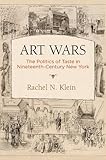Art Wars : The Politics of Taste in Nineteenth-Century New York / Rachel N. Klein.
Material type: TextSeries: America in the Nineteenth CenturyPublisher: Philadelphia : University of Pennsylvania Press, [2020]Copyright date: ©2020Description: 1 online resource (312 p.) : 40 illusContent type:
TextSeries: America in the Nineteenth CenturyPublisher: Philadelphia : University of Pennsylvania Press, [2020]Copyright date: ©2020Description: 1 online resource (312 p.) : 40 illusContent type: - 9780812251944
- 9780812296884
- online - DeGruyter
| Item type | Current library | Call number | URL | Status | Notes | Barcode | |
|---|---|---|---|---|---|---|---|
 eBook
eBook
|
Biblioteca "Angelicum" Pont. Univ. S.Tommaso d'Aquino Nuvola online | online - DeGruyter (Browse shelf(Opens below)) | Online access | Not for loan (Accesso limitato) | Accesso per gli utenti autorizzati / Access for authorized users | (dgr)9780812296884 |
Browsing Biblioteca "Angelicum" Pont. Univ. S.Tommaso d'Aquino shelves, Shelving location: Nuvola online Close shelf browser (Hides shelf browser)

|

|

|

|

|

|

|
||
| online - DeGruyter Early Modern Aristotle : On the Making and Unmaking of Authority / | online - DeGruyter Bonds of Secrecy : Law, Spirituality, and the Literature of Concealment in Early Medieval England / | online - DeGruyter Sustaining Life : AIDS Activism in South Africa / | online - DeGruyter Art Wars : The Politics of Taste in Nineteenth-Century New York / | online - DeGruyter Peopling the World : Representing Human Mobility from Milton to Malthus / | online - DeGruyter Former Guerrillas in Mozambique / | online - DeGruyter Public Service and Good Governance for the Twenty-First Century / |
Frontmatter -- CONTENTS -- Introduction. The Importance of Taste: Intellectual Roots -- Chapter 1. Paintings in Public Life: The Rise of the American Art-Union -- Chapter 2. The Limits of Cultural Stewardship: The Fall of the American Art-Union -- Chapter 3. Art and Industry: Debates of the 1850s -- Chapter 4. The Art of Decoration and the Transformation of Stewardship: The Making of the Metropolitan Museum of Art -- Chapter 5. Metropolitan Museum on Trial: Antiquities, Expertise and the Problem of Race -- Chapter 6. The Battle for Sundays at the Museum -- Epilogue. Edith Wharton’s Museum -- Notes -- Index -- ACKNOWLEDGMENTS
restricted access online access with authorization star
http://purl.org/coar/access_right/c_16ec
A study of three controversies that illuminate the changing cultural role of art exhibition in the nineteenth centuryFrom the antebellum era through the Gilded Age, New York City's leading art institutions were lightning rods for conflict. In the decades before the Civil War, art promoters believed that aesthetic taste could foster national unity and assuage urban conflicts; by the 1880s such hopes had faded, and the taste for art assumed more personal connotations associated with consumption and domestic decoration. Art Wars chronicles three protracted public battles that marked this transformation. The first battle began in 1849 and resulted in the downfall of the American Art-Union, the most popular and influential art institution in North America at mid-century. The second erupted in 1880 over the Metropolitan Museum's massive collection of Cypriot antiquities, which had been plundered and sold to its trustees by the man who became the museum's first paid director. The third escalated in the mid-1880s and forced the Metropolitan Museum to open its doors on Sunday—the only day when working people were able to attend.In chronicling these disputes, Rachel N. Klein considers cultural fissures that ran much deeper than the specific complaints that landed protagonists in court. New York's major nineteenth-century art institutions came under intense scrutiny not only because Americans invested them with moral and civic consequences but also because they were part and parcel of explosive processes associated with the rise of industrial capitalism. Elite New Yorkers spearheaded the creation of the Art-Union and the Metropolitan, but those institutions became enmeshed in popular struggles related to slavery, immigration, race, industrial production, and the rights of working people. Art Wars examines popular engagement with New York's art institutions and illuminates the changing cultural role of art exhibition over the course of the nineteenth century.
Mode of access: Internet via World Wide Web.
In English.
Description based on online resource; title from PDF title page (publisher's Web site, viewed 27. Jan 2023)


